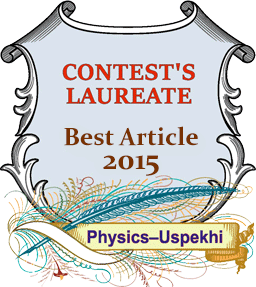 |
RSS feeds |
|
|||||
| Issue 12, 2025 |
|
||||||
|
|
|
||||||
Issues/2015/January |
← → |
| Reviews of topical problems |
Current progress in developing the nonlinear ionization theory of atoms and ions
a National Research Nuclear University ‘MEPhI’, Kashirskoe shosse 31, Moscow, 115409, Russian Federation
b Russian Federation State Scientific Center ‘A.I. Alikhanov Institute of Theoretical and Experimental Physics’, ul. Bolshaya Cheremushkinskaya 25, Moscow, 117259, Russian Federation

This paper reviews the status ofthe theory ofionization ofatoms and ions by intense laser radiation (Keldysh's theory). It discusses the applicability ofthe theory, its relation to the Landau—Dykhne method and its application tothe ionization ofatoms byultrashort nonmonochromatic laser pulses ofarbitrary shape. The semiclassical Imaginary Time Method is applied to describe electron sub-barrier motion using classical equations ofmotion with imaginary time t → it for anelectron inthe field ofanelectromagnetic wave. The paper discusses tunneling interference of transition amplitudes, a phenomenon generating fast oscillations inthe momentum distribution ofphotoelectrons. A nonperturbative account of the Coulomb interaction between the outgoing electron and the atomic residual causes significant changes in the photoelectron momentum distribution and in the level ionization rates, the latter usually increasing by orders of magnitude both for tunneling and multiphoton ionization. The effect of a static magnetic field onthe ionization rate and the magnetic cumulation process isexamined. The theory ofrelativistic tunneling isdiscussed, relativistic and spin corrections tothe ionization rate are calculated, and the applicability limits of the nonrelativistic Keldysh theory are determined. Finally, the application ofthe Fock method to the covariant description ofnonlinear ionization inthe relativistic regime isdiscussed.
|
Keywords: tunnel and multiphoton ionization, relativistic ionization, intense laser radiation, superstring magnetic field, Keldysh theory, imaginary time method
PACS: 03.65.Sq, 32.80.Fb, 32.80.Rm, 32.80.Wr, 34.80.Qb () DOI: URL: https://ufn.ru/en/articles/2015/1/b/  000352305900001 000352305900001  2-s2.0-84927132159 2-s2.0-84927132159  2015PhyU...58....3K 2015PhyU...58....3K Citation: Karnakov B M, Mur V D, Popruzhenko S V, Popov V S "Current progress in developing the nonlinear ionization theory of atoms and ions" Phys. Usp. 58 3–32 (2015) Received: 11th, July 2014, revised: 4th, October 2014, accepted: 15th, July 2014 Îðèãèíàë: Êàðíàêîâ Á Ì, Ìóð Â Ä, Ïîïðóæåíêî Ñ Â, Ïîïîâ Â Ñ «Ñîâðåìåííîå ðàçâèòèå òåîðèè íåëèíåéíîé èîíèçàöèè àòîìîâ è èîíîâ» ÓÔÍ 185 3–34 (2015); |
|
© 1918–2025 Uspekhi Fizicheskikh Nauk Email: ufn@ufn.ru Editorial office contacts About the journal Terms and conditions |